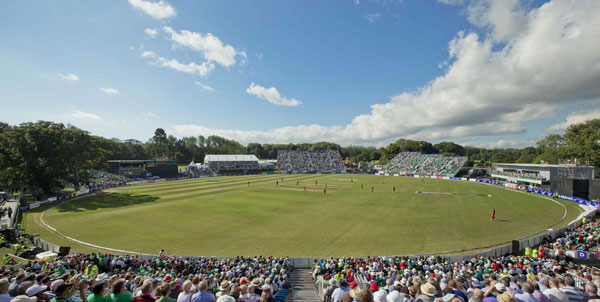 Cricket in Phoenix Park, circa 1830 - the ground in front of the Wellington Monument
Cricket in Phoenix Park, circa 1830 - the ground in front of the Wellington Monument
Recent research by MairÈad N' Muirchadha of the Old Dublin Society uncovered the earliest reference to Irish cricket, a 1731 report about the sons of the lord lieutenant playing in the park.
The sport's foundation myth previously had it that the first game took place in 1792 in the same park, a game between 'All Ireland' and the Garrison for which a report and scorecard was published. It was nothing like a representative selection, with both sides predominantly English or English-educated. One Irishman who did play was 23-year-old Arthur Wellesley of Summerhill, Co Meath, who grew up to be the Duke of Wellington.
Most of the early games involved the colonial administration and its troops, but Irish boys schooled in England brought it back too and by the 1830s Ballinasloe, Kilkenny, Carlow had strong sides, while Trinity and Phoenix ruled in the capital.
The growth of the railways helped the sport's spread, especially in northern towns and villages, and by the 1850s it was the biggest pastime in the land. In 1857 one nationalist writer, Carolan, lamented the 'passing' of football and hurling and their replacement by 'the stupid game of quoits or the more prevailing one of cricket.'
That obituary for Gaelic games was wildly off the mark. Cricket had been popular, but its roots were shallow and the native passion for hurling was impossible to dismiss once the GAA was founded in 1884.
Although Michael Cusack was a keen cricket and rugby player, he switched allegiances, writing that during the 1870s rugby 'came as a denationalising plague to carry on the work of ruin that cricket was doing in the summer.'
In his magisterial 'Sport & Ireland, A History', Paul Rouse writes that it was cricket's failure to establish an administrative structure that proved almost fatal as it became buffeted by the economic and social storms that raged over the half-century before independence.
Outside the cities, much cricket was run and sponsored by the Big Houses, but the Land Wars - ironically Charles Stewart Parnell was a talented cricketer - changed the atmosphere in many parts and its decline began.
An Ireland side first took the field in 1855, notching up impressive wins over MCC and other English sides. Four tours to the US and Canada were undertaken in the 30 years after 1879 but these were organised ad hoc, as no governing body existed. Clubs staged Ireland games and picked the team, which often led to rows and boycotts.
Skills were increasing and several players had good performances against touring sides. A Trinity student, Lucius Gwynn, actually topped the English batting averages in 1895, and was later picked for a Test but had to decline due to exams.
But the sport was already on the slide, and the GAA's increasing alignment with the national movement saw it introduce a vicious series of bans on its members playing or watching what it called 'foreign' games.
The first World War cut a swathe through a generation of young men, while independence saw the departure of the colonial apparatus that provided many players. The sport went into steep decline, mostly retreating to the cities and parts of Ulster.
 A packed ground at Malahide
A packed ground at Malahide
Wider access to UK television brought new audiences but the crucial moment came in 1993 when the ICU switched tack from being essentially a minor county playing in English competition to joining the ICC associate world.
World Cups were now on the horizon and players such as Ed Joyce and Niall O'Brien made careers in England. The heroics in the West Indies in 2007 brought in a whole new audience and sparked the fire that brought Cricket Ireland into life and professionalised the sport.
Charles and John Sackville could never have imagined what they were starting that sunny day back in 1731.
